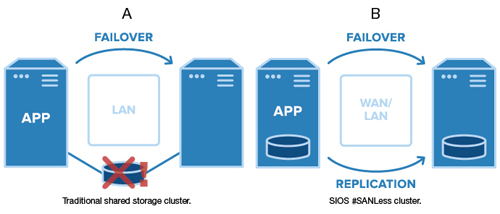Survey: Data Centers Need High Availability and Disaster Protection
By using local storage you not only eliminate the cost and complexity of a SAN, you also ensure fast, efficient SQL response times.
SAN MATEO, CALIF.— Last month, a company called SIOS Technology Corp. conducted a survey of large data centers to understand current trends and challenges related to providing high availability and disaster recovery for Microsoft’s SQL Server (a commonly used database for large amounts of data). The company hosting the survey said it has developed a better (more cost-effective) way of managing these two critical elements of data center and large file-based production operations.

Jerry Melnick, chief operating officer at San Mateo, Calif.-based SIOS Technology Corp., said protecting SQL Server from downtime and disasters was essential. For most survey respondents, controlling costs was the most significant challenge. The rising cost of Microsoft SQL licensing was next (17 percent), followed by vendor lock in (14 percent) and the cost of SAN storage (13 percent).
Jerry Melnick, Chief Operating Officer at San Mateo, Calif.-based SIOS Technology Corp., said video editing software also relies on powerful databases, such as SQL Server software, to store, find, retrieve, and manage video clips from their archives. For broadcasters, video production business, and other video-related businesses, protecting SQL Server from downtime and disasters is essential. However, the traditional way to provide high availability protection is with a shared-storage failover cluster, a potentially costly and complex process that can sometime slow performance. So, do you run your editing software without protecting SQL so end users have fast access to their video? Melnick said that means putting your systems at risk of complete downtime and significant data loss.
Most large data centers protect important SQL databases using clustering software. In a traditional cluster, the primary application server (where SQL is operated) is paired with a standby server in a “cluster” configuration. Both servers have access to the same data located on a shared storage device using a Shared Storage Area Network. If there is a failure on the primary server, clustering software moves the application operation to the standby server. In a Windows environment, Windows Server Failover Clustering software is typically used. Since the standby server is using the same shared storage as the primary server, SQL operation can continue without data loss.
While traditional clusters protect SQL from downtime, the shared storage SAN required in these clusters is often expensive and complex to deploy. They can also slow SQL response times, making them impractical for video editing and production systems.
Melnick said that SIOS has developed an easier and more cost-efficient way to protect the SQL Server databases when deploying a Microsoft Windows Server Failover Clustering architecture. It’s called SIOS DataKeeper Cluster Edition SANLess clustering software. The SIOS solution, he explained, allows you to use low cost, high speed server-side, local storage and eliminate the expensive SAN storage.
Get the TV Tech Newsletter
The professional video industry's #1 source for news, trends and product and tech information. Sign up below.
Melnick said the software uses “real time, block-level replication to synchronize the local storage on the primary and standby servers, making it appear to the WSFC software as identical to a SAN.”
If you are building a two-node cluster, he said, the company’s DataKeeper software can save money on SQL licensing costs because you don’t have to buy the more expensive SQL Server Enterprise Edition database—typically required in SAN environments. You’re still getting the high availability of files required and, with the SIOS software, you have greater flexibility in configuring servers for HA and DR applications. At the end of the day, Melnick said media companies could save significant costs (“tens of thousands of dollars”) by adding the DataKeeper software’s HA and DR features to their SQL Server Standard Edition deployments.

SANLess clusters (B) use real time, host-based replication to synchronize local storage on the primary and standby servers, making them appear to Windows Server Failover Clustering as a traditional cluster. “By using local storage you not only eliminate the cost and complexity of a SAN, you also ensure fast, efficient SQL response times,” he said. ““Unlike traditional clusters, SANLess clusters also allow you to use high performance SSD storage to ensure fast SQL performance and speed the process of finding and accessing the video information.”
Shared storage presents itsown set of costs and challenges, Melnick said, and the company’s survey reflected that. “According to our survey results, SANs are costly to administer. More than half (55 percent) spends more than $80,000 per year on SAN administration, including15 percent who spend more than $250,000 per year.”
More than half of respondents to the SIOS survey were from large enterprises with more than 1,000 employee (51 percent) and most were headquartered in the United States (76 percent); with 9 percent from EU countries. The survey pool represented a broad range of industries, including telecommunications (31 percent), healthcare (16 percent), and financial services (15 percent). Most had also purchased SQL Server Enterprise Edition licenses in the past two years.
Keeping operations running smoothly is the key to any data canter or video production and/or playout facility. That’s probably why most companies (68 percent) talking the SIOS survey said they purchased Microsoft’s SQL Server Enterprise Edition software instead of the cheaper SQL Server Standard Edition just to get the HA and DR features that are not included in the Standard Edition package. The Standard Edition does offer a “Database Mirroring Mode “(used for HA and DR), but some (7 percent) respondents found it “too labor intensive” to use.
